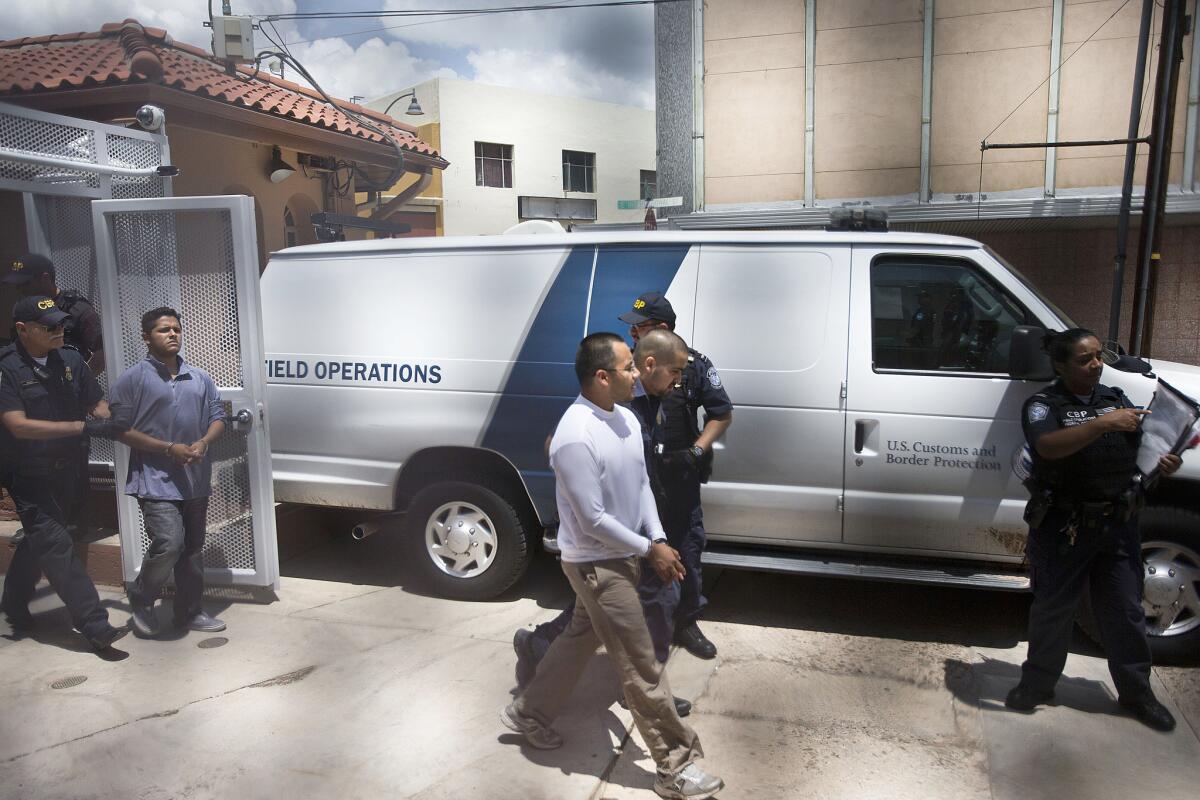Officials mulling deportation, release of ‘Dream 9’ in Arizona

TUCSON — At times, Marco Saavedra regrets what he did. The feeling overcame him a few days ago when he felt overwhelmed and anxious, questioning whether he’d ever get out of immigration detention. Then he thought of the others he’s met at the Eloy Detention Center in Arizona.
“There’s so much suffering. So many cases of struggle,” said the 23-year-old Saavedra, who was born in Mexico but grew up in New York City. “I think of these stories, and it makes it all worth it if I can even help one person.”
Saavedra is a member of the “Dream 9” — five women and four men brought to the United States illegally as children and who staged a risky and unorthodox protest more than two weeks ago at the U.S.-Mexico border.
Margo Cowan, attorney for the nine, said U.S. Citizenship and Immigration Services officials finished interviewing her clients this week and will probably hand down a decision soon on whether the Mexican nationals will be deported to their place of birth or released back to the American communities they’ve lived in most of their lives.
Saavedra, who spoke to the Los Angeles Times by telephone from immigration detention, said he and the other male activists have gathered stories from at least 20 other immigration detainees. Some are still waiting for an asylum hearing after months in detention. One man has been detained for more than a year, separated from his wife and children.
“A lot of the men here have no lawyers ... they have to do the legal paperwork for themselves and some don’t even speak English,” he said.
Saavedra and two other young adults also brought into the U.S. illegally — Lulu Martinez, 24, of Chicago and Lizbeth Mateo, 29, of Los Angeles — voluntarily flew back across the border recently in a protest to recognize the thousands of people deported from the country over the last five years under the Obama administration. They then attempted to reenter the United States at the Nogales, Ariz., port of entry with six other Dreamers, as the youths call themselves.
“These are young people who are the future of our country and they deserve to be able to document their status and continue their education and work and make the contributions they are poised to make,” Cowan said of the “Dream 9” and others like them.
On Tuesday, immigration asylum officers finished performing what is called “credible fear interviews” to determine whether the nine applications for asylum have enough merit to go before an immigration judge for a full hearing on their asylum claim, Cowan told the Los Angeles Times.
Citizenship and Immigration Services officials said they could not comment on the cases.
“Asylum applications are confidential under immigration law, and we may not discuss information regarding whether an individual has or has not filed an application,” agency spokeswoman Maria Elena Upson said in a prepared statement.
According to immigration law, if the asylum officer finds there is no credible fear in a case, the applicant could request a review by an immigration judge. If they don’t make such a request, they can be removed from the country.
If the officer finds there is credible fear of persecution or torture in their birth country, the case is referred to an immigration judge who would later decide whether to grant asylum.
An immigration hearing can take months, Cowan said. What’s unclear is whether the nine would be released on parole to their American communities with a notice to appear in court. There also is a chance they could be held in detention until their hearing.
The issue began July 22 when Saavedra, Martinez and Mateo demanded to be legally admitted into the U.S. at a border crossing in Nogales.
Martinez was brought into United States when she was 3, as was Saavedra. Mateo made a desert crossing on foot with her mother when she was 10.
The six who joined them also were brought to this country illegally as children but had returned to Mexico more than a year ago for various reasons. Most returned before immigration relief was made available under the Obama administration’s deferred deportation program, which allows immigrants who were brought into the country illegally as children to stay in the U.S., at least temporarily.
The “Dream 9” were part of an event orchestrated by the National Immigrant Youth Alliance. The name comes from the Dream Act, which would provide a path to legalization for young people who were brought into the country illegally.
As the nine await a decision, they’ve kept busy organizing within the facility, staging hunger strikes and gathering dozens of names and numbers of other people who are with them in immigration detention. Their case information has been passed to activists on the outside. The hope is to find these detainees some sort of immigration relief and to make their stories public, said Mohammad Abdollahi, organizer with the National Immigrant Youth Alliance.
Saavedra said he realized detention was a possibility that would be difficult to endure. Some detainees grow anxious and agree to be voluntarily removed because they can’t stand being cooped up any longer.
“For me, personally, it’s been overwhelming,” he said. “You just have to be patient.”
ALSO:
O.J. Simpson paroled on a few convictions but still owes jail time
An armed George Zimmerman gets warning for speeding in Texas
Weiner aide apologizes for outburst; intern who wrote tell-all accepts
Twitter: @thecindycarcamo
More to Read
Sign up for Essential California
The most important California stories and recommendations in your inbox every morning.
You may occasionally receive promotional content from the Los Angeles Times.











